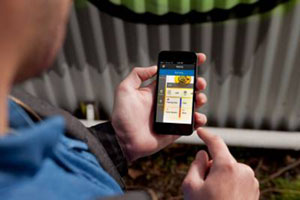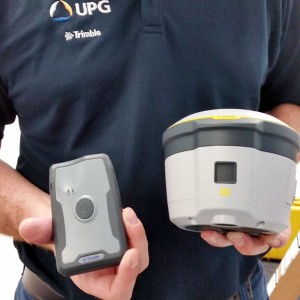GIS Data Gathering on your Phone
Iain Barnfield, National Sales Manager, UPG
 When you consider that around 65% of Australians own a smart phone, and are proficient in using it, it’s not surprising the potential that smart phones bring to companies. Staff can check their email, organise their day, take photos of potential problems, and of course take calls wherever they are.
When you consider that around 65% of Australians own a smart phone, and are proficient in using it, it’s not surprising the potential that smart phones bring to companies. Staff can check their email, organise their day, take photos of potential problems, and of course take calls wherever they are.
In the Geospatial area it brings even more potential, as smart phones have the ability to log basic geospatial data, and there are apps by Trimble or ESRI, which allow you to geocapture data, complete condition reports and complete forms with asset information. These apps are designed to allow the easy transfer of that data into a back end GIS system in the office.
But, are your smart phone and the apps above enough for you to do your job? That really depends on what your job involves. With their lovely big screens, smart phones chew through the batteries -not the best for working regionally. The physical limitations of a smart phone can also make it difficult to use as a GPS; the screen can be difficult to see outdoors and they are not designed for use while mounted on a dashboard. Also, as some of us have found out the hard way, they are not the sturdiest of tools.
 Plus as I’m sure we all know the availability of the mobile networks is not always great. However for GIS professionals, the main issue would be that the accuracy levels of a smart phone. Most people believe that the GPS on their phone is accurate, however most GPS receivers in smart phones are only five to 10 meters at the best. While this is fine when you want to locate a new place to have lunch, it is not fantastic for a professional trying to locate a specific access panel when the grass has grown over it.
Plus as I’m sure we all know the availability of the mobile networks is not always great. However for GIS professionals, the main issue would be that the accuracy levels of a smart phone. Most people believe that the GPS on their phone is accurate, however most GPS receivers in smart phones are only five to 10 meters at the best. While this is fine when you want to locate a new place to have lunch, it is not fantastic for a professional trying to locate a specific access panel when the grass has grown over it.
There are ways to overcome some of these obstacles, plug in battery packs or car chargers are great ways to keep the charge to your phone, for example. A protective case and screen protectors can toughen it up and make it easier to see outdoors.
 To increase accuracy, there is now the option of linking to a receiver which can give sub-meter accuracy. Trimble has two GNSS receives designed specially to enhance your smart phone’s accuracy, the R1 which can fit in your pocket, and the R2 which can easily be mounted into a backpack.
To increase accuracy, there is now the option of linking to a receiver which can give sub-meter accuracy. Trimble has two GNSS receives designed specially to enhance your smart phone’s accuracy, the R1 which can fit in your pocket, and the R2 which can easily be mounted into a backpack.
This means, that now companies have a way to maximise the use of existing assets and delivering a higher level of accuracy when you require it.
 You have the option of using your smart phone with the apps or linking it with either receiver. Whichever way you chose to go it’s exciting to be in an era when highly portable handheld devices can do the job that was previously only possible with large and bulky survey-grade tools.
You have the option of using your smart phone with the apps or linking it with either receiver. Whichever way you chose to go it’s exciting to be in an era when highly portable handheld devices can do the job that was previously only possible with large and bulky survey-grade tools.
Read more about mobile devices for data gathering
![]() Read the Trimble paper on Addressing the Mobile Device Accuracy Issue
Read the Trimble paper on Addressing the Mobile Device Accuracy Issue
 About Iain Barnfield
About Iain Barnfield
Iain Barnfield is the National Sales Manager for UPG.

